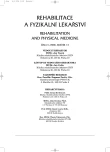Advances i n Physiotherapy as Reflection of Scientific Paradigms and Discoveries
POKROKY FYZIOTERAPIE JAKO ODRAZ VĚDECKÝCH PARADIGMAT A OBJEVŮ
Autorka příspěvku osvětluje důležité mezníky ve vývoji fyzioterapie, a to zejména vzhledem k vědeckým poznatkům týkajících se řízení motoriky. Poukazuje na významná paradigmata a objevy, které ovlivnily vývoj fyzioterapeutických metod a konceptů. Rovněž tak poukazuje na problémy s vědeckou průkazností efektivity fyzioterapie.
Klíčová slova:
fyzioterapie, vědecká paradigmata, fyzioterapeutické koncepty, efektivita fyzioterapie
Authors:
D. Pavlů
Authors‘ workplace:
Katedra fyzioterapie, FTVS UK, Praha
vedoucí katedry doc. PaedDr. D. Pavlů, CSc.
Published in:
Rehabil. fyz. Lék., 13, 2006, No. 1, pp. 16-20.
Category:
Original Papers
Overview
The author explains important milestones in the evolution of physiotherapy, especially in view of scientific discoveries concerning motor (movement) control. The author refers to important paradigms and discoveries that influenced the evolution of physiotherapeutic methods and concepts. She also draws attention to the problem of scientific conclusive evidence for efficiency of physiotherapy.
Key words:
physiotherapy, scientific paradigms, physiotherapeutic concepts, efficiency of physiotherapy
Labels
Physiotherapist, university degree Rehabilitation Sports medicineArticle was published in
Rehabilitation & Physical Medicine

2006 Issue 1
- Hope Awakens with Early Diagnosis of Parkinson's Disease Based on Skin Odor
- Deep stimulation of the globus pallidus improved clinical symptoms in a patient with refractory parkinsonism and genetic mutation
Most read in this issue
- Possibilities of Therapeutic Climbing in Physiotherapy
- Cervical Spine in Relationship to Etiology Disorders of Cervical Region
- Clinical Significance of Trigger Point in Acromial Part of Deltoid Muscle
- Significance of Soft Parts in the Origin of Sacroiliac Dysfunctions in Posttraumatic Conditions of Lower Extremities
